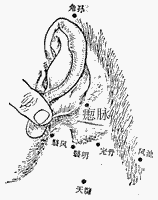bubble_chart Etymology "Chi" (瘛), convulsions or spasms; "mai" (脈) refers to the bluish vessels behind the ear, resembling a chicken's foot. The appearance of these bluish vessels is a sign of convulsions in infants. The acupoint is located on this vessel and is effective in treating convulsions.Huangdi Neijing Taisu: "When the bluish vessels behind ear become prominent, it indicates convulsions and pain." Yang Shang-shan's note: "The bluish vessels behind ear belong to foot shaoyang gallbladder meridian. In infants, when there is no pain, the vessels are sunken; when there is illness, they become prominent, which is a sign of convulsions and pain."
bubble_chart Location
Located on head, at the center of mastoid process of temporal bone, between posterior border of ear root and posterior hairline, at lower one-third point of the arc connecting
Yifeng (TE17) and
Jiaosun (TE20) along helix. It is level with
Tinghui (GB2).
- Zhenjiu Jiayi Jing: "At the bluish vessel resembling a chicken's foot behind the base of ear";
- Xunjing Kaoxue Bian: "Adjacent to Yifeng (TE17) behind ear, level with Tinghui (GB2) in front";
- Zhenjiu Jicheng: "One cun above Yifeng (TE17), slightly closer to ear root".
bubble_chart Anatomy
- Muscle: posterior auricular muscle.
- Nerve: posterior branch of greater auricular nerve.
- Vessel: posterior auricular artery and vein.
bubble_chart Manipulation
Insert horizontally or obliquely toward ear, 0.3 to 0.5 cun in depth, or use a pricking technique. Moxa stick warm moxibustion for 5 to 15 minutes.
bubble_chart Efficacy
Improve vision, calm fright and stabilize epilepsy
- Classical: headache, spasm and convulsion, vomiting, tinnitus, deafness, pain behind ears, blurred vision, infantile fright epilepsy.
.
- Modern: reduced vision.
bubble_chart Combinations
- Head wind and pain behind ear: Chimai, Wangu (GB12).
- Infantile fright epilepsy: Chimai, Changqiang (GV1).
bubble_chart Other Related Items
